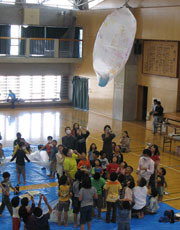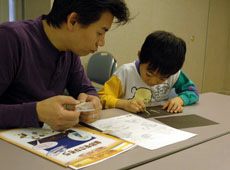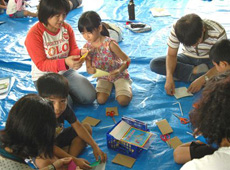Q. Could you tell us about the Space School program.

Hot air balloon flying high in the air
Space School offers a year-long home-learning program, mainly for children five to seven years old, before they start to study science at school. At present, working with local boards of education and Rotary Clubs, we have set up about 20 Space Schools nationwide, from Hokkaido to Okinawa, and they are open to new applicants. Enrollment requires participation by both parent and child.
The opening ceremony is held at the first classroom session, where home-study materials are handed out. After that, classes are held to bring everyone together every two to three months, and in between, participants study at home. What materials to use and how many assignments to give out is up to each school, but the parent and child must work together. About five classes are held throughout the year, and for those we choose topics that cannot be tried out at home. For example, one home lesson involves floating a small bag using a common hair dryer, but in the class everyone works together to build a large hot air balloon that rises 30 to 40 meters in the sky.
Space School offers many different materials to meet a variety of demands from children. The materials are generally in the form of pamphlets that introduce experiments and observations that can be carried out using objects found in the home. To stimulate children's curiosity, these pamphlets are designed from their point of view. For example, it is important to title materials in a way that children can easily understand. For instance, when the topic of the experiment is "absorption reaction," the title will be "Why does my mouth feel cool when I eat fizzy candy?" Also, sometimes, we deliberately avoid detailed explanations, to encourage children to make discoveries on their own, and also to create an opportunity for their parents to join in. We plan to develop 14 new home-lesson kits this year, so that we'll have over 60 in total. That means that even if a child does one home lesson every week, it will take more than a year to go through them all.



